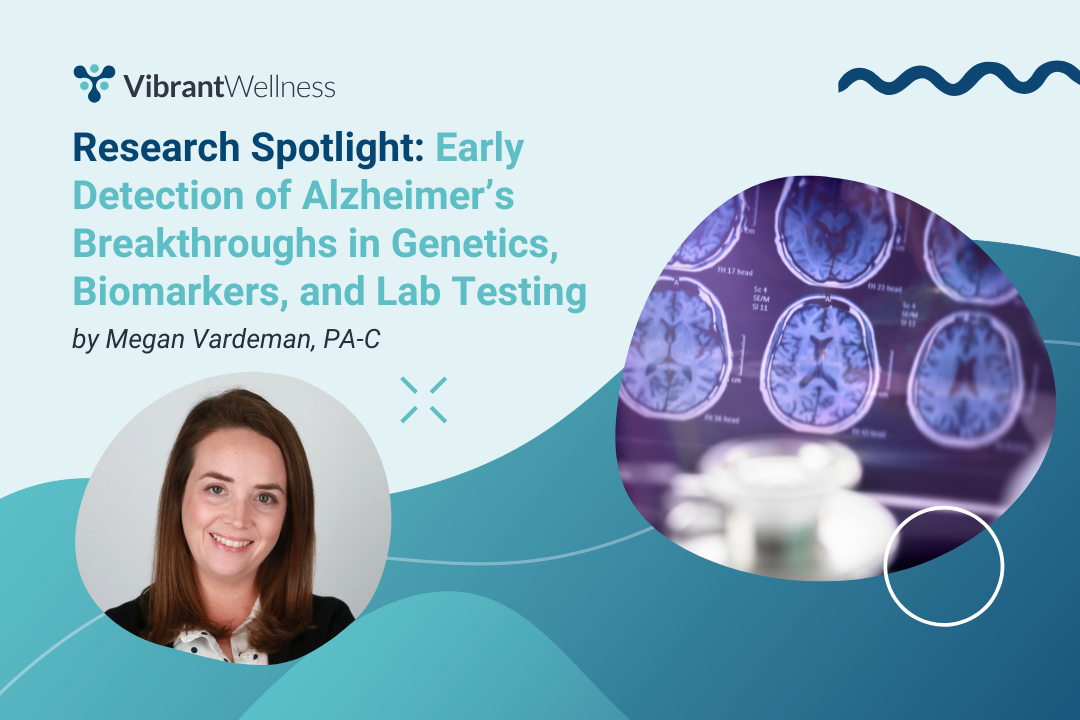Research Spotlight: APOE Genetic Polymorphisms & Age-Related Disease
When considering age-related diseases like heart disease and Alzheimer’s, lifestyle factors like diet, stress, and environmental toxins often come to mind.
However, genetic factors can substantially increase your risk before you’re even born.
One crucial gene linked to both cardiovascular and neurological diseases is APOE or Apolipoprotein E, which codes for a protein critical for fat metabolism in the body.
In this article, we’ll evaluate the predictive ability of APOE genetic polymorphisms in the development of cardiovascular disease and Alzheimer’s and highlight key findings from recent Vibrant research that emphasize this relationship.
What is APOE?

APOE is a protein composed of 299 amino acids and encoded by the APOE gene. The protein’s primary function is to facilitate lipid transfer between circulating lipoproteins and tissues by binding to membrane receptors.
Transport and Function of Lipoproteins
APOE’s role extends to binding lipids to form lipoprotein complexes, which circulate throughout the body, transporting essential lipids like cholesterol and triglycerides.
This action ensures the smooth functioning of lipoproteins, regulating blood lipid levels and preventing build-up in arteries or atherosclerosis—an essential part of cardiac health.
Neurological Implications of Lipid Transport
Lipid transport is also vital for neurological health. The brain relies on lipids for several mechanisms, including insulating neurons with myelin sheath, which is composed of lipids.
Further, lipids like cholesterol serve as signaling molecules vital in neuronal differentiation and synaptogenesis—both crucial processes for maintaining brain health.
As a major component of the most abundant lipoprotein in the brain, APOE's functional presentation has a significant impact on brain health. Transporters like APOE are key in facilitating lipid transfer between neurons and glial cells, while microglia are tasked with cholesterol clearance.
Any disruption in this lipid regulation can trigger inflammation, a major hallmark of Alzheimer’s.
WATCH: Connecting the dots of infections, neuroinflammation, and neurological degeneration:
APOE’s role isn’t limited to lipid management—it also binds to inflammatory substances in the body, which helps clear out pathogens and reinforces the first line of the innate immune response.
The Two Types of APOE
There are two main locations where APOE is found in the body: Peripheral tissue and the central nervous system (CNS), where it plays a prominent role in cardiac and neural health.
Peripheral APOE
In the periphery, the protein is primarily expressed by the liver and involved in digestion and detoxification.
However, in conditions of excessive lipid accumulation or stress, other cells like macrophages and adipocytes can also produce APOE.
This adaptability underscores the critical role of peripheral APOE in lipid metabolism regulation and its potential impact on cardiovascular health and systemic inflammation.
The protein's different isoforms—APOE2, APOE3, and APOE4—each have unique affinities for lipoprotein particles like VLDLs, LDLs, and HDLs. These interactions are crucial, as they influence the metabolism of lipoproteins and, thus, the body's lipid profile. Given the importance of lipid management in preventing atherosclerosis, the isoform-specific binding properties of APOE are a significant factor in cardiovascular disease.
Additionally, genetic variation in the APOE gene can influence inflammation by affecting serum C-reactive protein (CRP) levels, a well-established marker of inflammation and predictor of cardiovascular events.
These intricate interactions between APOE, lipoproteins, receptors, and inflammatory signaling pathways impact the regulation of lipid metabolism and inflammation in peripheral tissues, which can trigger disease development in the heart and brain and affect the body’s overall inflammation levels.
Central Nervous System APOE
APOE can also be found in the CNS, where it’s produced in the brain.
Brian cells that produce APOE include astrocytes, oligodendrocytes, microglia, choroid plexus, and neurons after stressful events.
Its major role in the brain underscores its importance in lipid homeostasis, influencing neuron integrity and function by regulating membrane architecture, lipid-dependent signaling, and lipid detoxification.
Genetic Polymorphisms

The APOE gene produces six different genotypes, each affecting cellular functions and resulting in varying degrees of disease risk.
The different genotypes can significantly alter the structure and function of the protein.
In humans, APOE exists as three common variants: APOE2 (cysteine, cysteine), APOE3 (cysteine, arginine), and APOE4 (arginine, arginine), which allow for six different genotypes.
Homozygous genotypes include:
- APOE 2/2
- APOE 3/3
- APOE 4/4
Heterozygous genotypes include:
- APOE 2/3
- APOE 2/4
- APOE 3/4
Your chance of developing diseases of the heart or brain can vary significantly based on which genotype you inherit.
APOE Genetic Variations & Early Disease Markers

“Association of APOE polymorphisms with serological lipid and inflammatory markers” is a 2023 study conducted by Vibrant Clinical Labs and published in Research Square.
The study aimed to assess the association of apolipoprotein E (APOE) gene polymorphisms with vital serological lipid and inflammatory markers to determine their potential role in predicting the risk of cardiovascular diseases (CVD) and Alzheimer's disease (AD).
Researchers tested 916 individuals for 12 lipids and four inflammatory biomarkers at Vibrant America Clinical Laboratory.
Lipid markers included:
- Total cholesterol
- LDL (Low-density lipoprotein)
- HDL (High-density lipoprotein)
- Triglycerides
- Apo A-1
- Apo B
- Lp(a) (Lipoprotein a)
- BNPNT (B-Type Natriuretic Peptide N-Terminal)
- sdLDL (Small Dense Low-Density Lipoprotein)
- ox-LDL (Oxidized Low-Density Lipoprotein)
- Apo B: Apo A-1 (ratio of ApoB to ApoA)
- LDLCAL (LDL Calculated)
Inflammatory markers included:
- hsCRP (High-Sensitivity C-Reactive Protein)
- Hcy (Homocysteine)
- MPO (Myeloperoxidase)
- PLAC (Lipoprotein-Associated Phospholipase A2)
Clinical data, blood lipid and inflammatory profiles, and APOE genotyping were analyzed using a polymerase chain reaction-restriction fragment length polymorphism technique and PCR-RFLP using a real-time PCR system.
The Results
The study identified a strong correlation between APOE gene polymorphisms and abnormal serum lipid and inflammatory profiles.
The APOE4 genotype was linked to dysregulated lipid metabolism, abnormal inflammatory markers, and low levels of cardio and neuro-protective markers (specifically E4/E4), increasing the risk of CVD and AD.
Individuals with the APOE2 genotype (specifically E2/E4) showed lower levels of various lipid markers and all inflammatory markers.
This demonstrates a potential protective effect of the APOE2 genotype against lipid and inflammatory markers.
By promoting efficient lipid metabolism and reducing cholesterol accumulation in arteries and the brain, the APOE2 genotype may help prevent the development of heart disease and Alzheimer’s disease.
Thus, one’s risk of developing cardiac and neural diseases can be greatly influenced by which APOE genotype they inherit.
Testing for the APOE Genotype
Neural Zoomer Plus

Early detection is crucial for preventing and managing brain diseases.
Using precision testing like the Neural Zoomer Plus, you can help your patients learn if they are genetically predisposed to developing neurological conditions like Alzheimer’s.
While the Neural Zoomer Plus detects neurological autoimmunity, the genetic add-on of this test also tests for the presence of the APOE genotype, detecting genetic predisposition for certain neurological conditions.
By identifying your patients’ APOE genotype, you can assess their risk of developing neurological disease and create personalized treatment plans to help prevent neurological degeneration.
Download our comprehensive sample report to see the full list of Neural Zoomer Plus biomarkers and reference ranges.
Testing for Cardiac Health
Cardiac Health Panel

To assess overall cardiac health, you can utilize precision testing like the Cardiac Health Panel.
This test evaluates the presence and risk of cardiovascular disease.
The panel tests for various markers of heart health including “healthy” and “unhealthy” cholesterol levels, inflammatory markers, myocardial stress, lipoprotein levels, and fatty acid levels.
This cardiac health test also helps determine genetic predisposition for developing specific cardiovascular and related diseases by testing for levels of Lp(a)—a known genetic risk factor for heart disease.
For the test’s full range of markers, download the Markers List.
Testing for significant cardiac health biomarkers, as well as genetic risk factors, will help you detect heart disease earlier in your patients and guide custom treatment plans to prevent cardiac distress and promote longer, healthier lives.
APOE and Preventative Medicine
The APOE gene can have a significant impact on neurological and cardiac health, affecting disease risk in different ways depending on a person's APOE genotype.
While cardiovascular disease and neurological conditions like Alzheimer’s may seem different, they share a common factor in the APOE gene's impact on bodily functions.
You can improve early risk assessments by identifying APOE polymorphisms and understanding their interplay with lipid metabolism and inflammation.
Combining this knowledge with lifestyle and environmental factors enables personalized interventions to mitigate the risk of cardiovascular disease and neurological degeneration.
Regulatory Statement:
The general wellness test intended uses relate to sustaining or offering general improvement to functions associated with a general state of health while making reference to diseases or conditions. This test has been laboratory developed and its performance characteristics determined by Vibrant America LLC and Vibrant Genomics, a CLIA-certified and CAP-accredited laboratory performing the test. The lab tests referenced have not been cleared or approved by the U.S. Food and Drug Administration (FDA). Although FDA does not currently clear or approve laboratory-developed tests in the U.S., certification of the laboratory is required under CLIA to ensure the quality and validity of the test
 By
By



